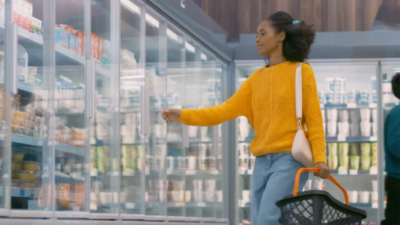2021 Year-in-Review
The U.S. retail sector had a phenomenal year in 2021 as we saw a definitive correction due to the surplus of retail square footage and the considerable shift of consumer spending behaviors as retailers looked to regain their share of the market. Convenience, flexibility, and innovative consumer engagement were top of mind for consumers. In addition, the desire to shop and socialize in person was evident as online sales cut back throughout the year. Overall retailer profitability recovered as shopper foot traffic in stores improved significantly from last year’s levels. Total retail sales rose by 19.3% on a year-over-year basis, the equivalent of Americans spending $1.2 trillion more than they did in 2020.
The U.S. retail market saw 76.5 million square feet of space absorbed in 2021 as announced store closings hit an all-time low while announced store openings outpaced closings for the first time since 2014. The vacancy rate stood at 4.6% at the end of the year for retail assets, decreasing by 40-basis points year-over-year.
3 Trends to Watch in 2022
- Small-Format Stores
Retailers are testing new concepts to optimize their overall ability to reach customers better. Last year, Target began to open dozens of Ulta mini shops while Sephora launched stores within Kohl’s locations. In addition, Macy’s launched “off-mall” store formats of Market by Macy’s, and Bloomingdale’s opened its first small Bloomie’s store. We expect these smaller store formats to drive wider adoptions and brand interest for well-established retailers looking to diversify their mix.
- Live Commerce
Livestreaming, a real-time, interactive video stream that sells products, often on social platforms, brings in-store personal service to the screen by enabling viewers to comment during the events. An advantage to live shopping is that it creates space for an interactive dialogue between brands and customers that accelerate the purchasing journey. As a result, the global social commerce industry is expected to grow three times as fast as traditional e-commerce, from $492 billion in 2021 to $1.2 trillion by 2025 by Gen Z and millennial consumers.
- Digitally Native Brands Physical Expansion
Many digitally native brands are now turning to physical locations to help expand potential reach. The success of physical expansion has been proven by digitally native brands like Warby Parker, Allbirds, and Everlane. These brands are proving that wider omnichannel approaches are critical to driving growth. The entry of more chains into the retail mix creates a greater level of brand diversity and offers a wide, new pool of potential tenants. By 2025, we estimate that a physical location will fulfill 30.5% of all digital transactions.
U.S. National Retail Forecast
Vacancy Outlook
The vacancy rate for the U.S. retail market dropped below 5% at the end of 2021 and is expected to continue on a downward trend into 2022 as retailers continue to expand and retail openings now outpace closings. Retail leasing activity accelerated to its highest levels in four years in 2021, with more than 240 million square feet of space leased, an increase of more than 30% from the multi-decade low seen in 2020. The majority of new retail space delivered in 2021 consisted of freestanding single-tenant properties, with nearly 75% of under construction retail space preleased at the end of the year. The resurgence in leasing activity was driven by strong growth for smaller spaces, as the average footprint leased fell to a new historical low during the year to just over 3,000 square feet.
We will continue to see accelerated leasing activity throughout 2022 that will drive vacancies down across all retail subtypes in suburban markets experiencing the strongest population and buying power growth. Urban and downtown cores are expected to recover at a more moderate pace as workers slowly return to the office.
Lease Rate Outlook
Rising retail sales and the demand for space collectively lead retail rent growth to accelerate by 3% at the end of 2021, the strongest nominal growth rate recorded in over a decade. In addition, rent collection remains an important theme across the retail sector. The market is inching closer to pre-pandemic rent collection levels, evidenced by the 91% collection rate in 2021 compared to 86% collected in 2020.
Tenants will continue to have the upper hand in lease negotiations as landlords remain flexible regarding lease terms, TI allowances and concessions. Suburban retail rents are expected to grow by 4.1% this year, while properties in urban markets will increase by 3.8%. Rapidly expanding markets such as Las Vegas, Atlanta, Nashville, and Inland Empire are forecast to see rental growth surpass 7%. In contrast, markets such as Milwaukee, Baltimore, St. Louis, and Boston are expected to see rental growth of less than 3% in 2022.
Absorption Outlook
The U.S. retail market absorbed 76.5 million square feet of space in 2021, the highest figure recorded since 2017. Shopping centers accounted for nearly 45% of the positive absorption as the subtype has benefited from strong growth in demand from quick-service restaurants, discounters, grocers, home goods and decor, and home improvement categories. We will continue to see positive absorption in 2022 but will fall short of 2021 as consumers become more modest with their spending due to supply-chain concerns and inflation.
New supply is not expected to materially impact vacancy rates as the limited amount of speculative projects under construction are located in projects within high-growth markets. Asset-level performance will vary with outperformers, including open-air shopping centers in the South and West. Meanwhile, centers without grocery anchors in slower-growth regions are expected to struggle to retain and expand their tenant mix.
Capital Markets Outlook
Investors are racing back into retail, with sales volume consistently improving throughout 2021, reaching $84 billion. Fourth-quarter sales accounted for nearly 36% of total sales for the year. Average retail values increased 10% year-over-year to $204 per square foot. Retail values have been supported by ultra-low interest rates and significant demand for higher-quality net-lease deals in a low-yield environment. Improving cash flows has also made investors more risk tolerant as sales of multi-tenant retail assets increased toward the second half of the year.
Supported by forecasts calling for the strongest NOI growth in five years, retail pricing is forecast to rise by 5% in 2022, which would be the largest rise in values since 2015. Investors will continue to target grocery-anchored centers and will begin to show more optimism in urban core retail. While interest rates are expected to increase in 2022, there is room for rates to rise without significantly impacting cap rates so long as capital remains abundant and retail fundamentals continue to improve.

 Nicole Larson
Nicole Larson

 Anjee Solanki
Anjee Solanki
